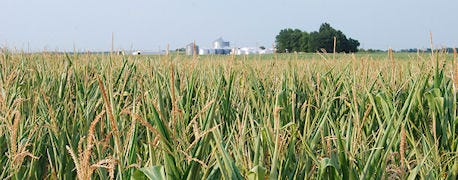August 10, 2012

When a corn plant is stunted, or not growing normally, nitrates can build up in the plant. Typically, nitrogen that is taken up by the corn plant is converted to amino acids ? the building blocks of protein ? but in the stressed plant this conversion does not occur. And that's why producers need to know how to properly handle and feed drought-damaged corn in silage form, says Steve Ensley, of Iowa State University's veterinary diagnostic and production animal medicine department at Ames.

Be Careful Feeding Droughty Corn As Silage
"The nitrate level can be high enough in stunted plants that if harvested as silage the nitrate can be toxic to livestock that consume the silage," Ensley warns. "The most common problem is when drought-stressed corn is green chopped and fed to livestock without going through ensiling."
Ensiling will lower the amount of nitrate in the plant. Nitrogen availability to the plant, which will depend on recent rain, fertilizer applied and other factors, will affect the level of nitrate in the plant. If producers are planning on making silage from drought damaged corn, the only way they can be sure about the level of nitrate is do some sampling and testing of the corn silage before feeding.
Important to do proper sampling and testing of corn silage before feeding
"Farmers have several options to help determine whether nitrate toxicity might be a problem," Ensley says. "You need to assess the cornfield that will be harvested as silage or green chop to determine how much of the field has stunted corn that's not developing a normal ear. Gather some samples either by taking grab samples of silage cut by a forage chopper or by cutting several entire plants by hand that represent the various types of corn in the field."
~~~PAGE_BREAK_HERE~~~A quick test that will screen for the presence of nitrates in stalks without having to chop the stalk can be done by ISU Extension beef and dairy specialists. A drop of diphenylamine in sulfuric acid on the surface of a stalk split in two will turn a blue-black color if nitrate is present. However, this does not provide a concentration of nitrate. Availability of this screening test varies. In some cases, the screening test may be a part of drought meetings where the beef or dairy field specialists are present.
Take necessary precautions when feeding drought-damaged corn as silage
Other options include getting a representative sample of several stalks and performing a strip test, which can help determine the concentration of nitrate by sending in a sample to a testing lab. ISU Extension beef and dairy specialists also will have capability for this, but due to the time required to prepare the sample for analysis the availability will be more limited than the screening test. Samples also can be sent to commercial feed analysis labs, or your veterinarian can send samples to the Iowa State veterinary diagnostic lab at Ames.
For more information on nitrate toxicity in drought damage corn silage, see the fact sheet "Nitrate Toxicity" on the Iowa Beef Center website. Producers also can contact their ISU Extension beef specialist or dairy specialist. Additional drought-related information is available on the Extension and Outreach Dealing with Drought website and the Iowa Beef Center website.
You May Also Like




